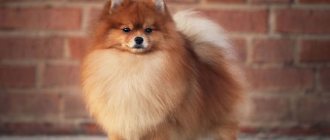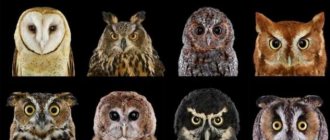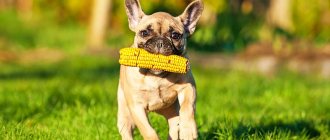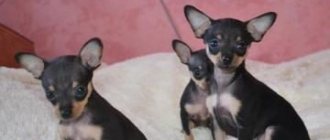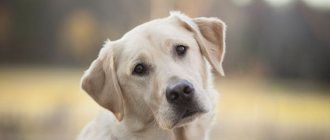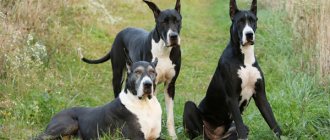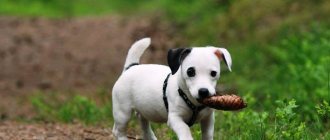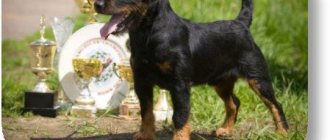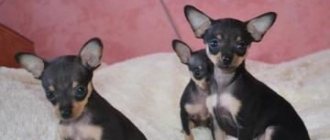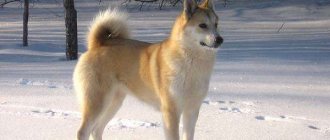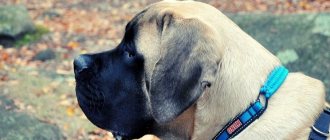Home » Dog Breeds
Parenting skills, the power of love and patience are fully tested when a Staffordshire Terrier puppy arrives at home.
These energetic and curious kids will not let you get bored.
By paying enough attention to their proper upbringing, you will get a dog that you will be proud of.
- 2 Accustoming to neatness
- 3 Vaccinations for Staffordshire Terrier puppies
- 4 Raising a Staffordshire Terrier puppy
- 5 Physical activity
- 6 Contact with the owner
Feeding Staffordshire Terrier puppies
Before you buy a Stafford puppy, you need to decide what you will feed him - natural products or dry food , as well as where his bowls and resting place will be located.
Once you have decided on a feeding location, follow the generally accepted rules.
You cannot force your baby to eat. The reason for refusal may be poor quality food or illness of the puppy.
Under no circumstances throw food from your table to your dog, otherwise he will never learn to wait for food in the designated place.
Do not feed him with a spoon or your hands, because later it will be difficult to teach him to eat from a bowl.
Do not replace food with treats if the baby is naughty and does not eat, otherwise he will understand that he can “download his rights.”
Puppies sense very subtly when the owner “gives up slack” and can perfectly take advantage of this opportunity.
With this behavior they resemble their brothers - Bernese Mountain Dog puppies .
At the same time, you cannot force your baby to eat.
The reason for refusal may be poor quality food or illness of the puppy.
When eating, the dog, like a St. Bernard puppy , should be taught the correct stance.
Carefully place its front legs parallel to each other, and its hind legs so that their joints form a right angle.
In order for an adult dog to have correct posture, its bowls must be fixed on a special stand.
The height of the latter should reach the baby’s chest or be slightly higher.
Under no circumstances throw food from your table to your dog, otherwise he will never learn to wait for food in the designated place.
After the terrier eats, the remaining food must be removed. But the bowl of fresh water should remain full all day.
As for choosing the type of food - dry food or natural products, there are some nuances here.
If your choice is dry food, it should be of high quality. Stafford puppies is accompanied by recommendations in this regard.
If you decide to feed your baby food other than what the breeder gave him, you still need to give the puppy his usual food for some time, gradually introducing something new.
If your choice is natural products, make it a rule to include the following in your dog’s menu:
- meat and offal, boiled and cut into pieces
- soft boiled eggs
- milk and dairy products
- sea fish, boiled, without large bones
- cereals, except pearl barley and whole oatmeal
- vegetables other than potatoes and legumes
- fruits
Stafford puppies miss their mother very much. Make sure your baby is surrounded by your attention and care
The share of protein foods in the diet should be 30% or more.
Under no circumstances should you add spices, salt or sugar to your dog's food.
Other “don’ts” include:
- confectionery
- sausages, frankfurters, various smoked meats
- fat meat
Dog character
Staff is a smart and good-natured dog. Despite his rather intimidating appearance, sudden outbursts of aggression are completely atypical for him. The dog simply adores small children. She is optimally suited for large families and will become a loyal, devoted and reliable friend. However, only proper upbringing and care will help the dog show its best qualities.
The long history of Staffordshire Terriers dates back to distant England, where the ancestors of this breed, the English Bulldogs, grew up.
There are several characteristic breed traits that owners should be aware of.
- Staffs are very obedient and easy to train. The dog easily remembers what pranks are acceptable in the house, and what is strictly prohibited. Training an animal is absolutely easy. Even a child over 10 years old can easily cope with this task, but only under the close supervision of adults. Even small puppies quickly get used to obedience. For this quality they are highly valued and are often recruited to work in search and rescue services. It is representatives of this breed that become the best guides and rescuers. These dogs earned universal love during the rescue operation in Nord-Ost. With their help, specialists inspected objects before the assault began.
- Activity is another key quality of pets. They simply love having fun and cannot imagine their life without running, long walks and jumping. The more time the owner is willing to devote to the dog and the more games he offers it, the better. Staffords are absolutely not suitable for homebodies. If the dog does not expend his seething energy on a walk, he will definitely splash it out at home, causing serious damage. Therefore, it is extremely important to find time for long walks and games.
- Many people believe that the Staffordshire Terrier has an aggressive nature and is not averse to feasting on strangers. In fact, this is completely not true: the breed is very social, dogs love when their owners greet guests and adore children. Pets condescendingly tolerate all the tricks and pranks of younger family members, play with them with pleasure and even act as nannies. Staffs are no less friendly towards other four-legged animals they meet on a walk.
Staff is a smart and good-natured dog
Experienced dog breeders unanimously claim that the breed itself is incredibly loyal, friendly, calm and peaceful. This dog poses no threat. But the owner who trains and gives commands to the pet is dangerous for those around her. The staff obeys the owner unquestioningly and, without hesitation, carries out any order.
The fighting nature of Staffordshire Terriers manifests itself exclusively in battle. The dog is extremely aggressive towards the enemy; it is simply impossible to control him here. Therefore, all individuals that at least once showed aggression and hatred towards humans were immediately removed from breeding. This was done not only for safety, but also so that during dog fights opponents could be pulled apart with bare hands without fear of getting hurt.
Accustoming to neatness
In general, the Stafford should be trained by rewarding desirable behavior.
You need to take the puppy outside to do his “business” every time he eats or wakes up, and also every two to three hours.
Yes, it’s troublesome, but literally in a week or two the baby will understand what they want from him, and there will be no problems with puddles and piles.
Stafford puppies are particularly savvy, as are shorthaired pointer cubs .
As soon as the dog appears in your home, determine where his place to rest and sleep will be. It’s good when the baby chooses a corner for himself where you take his bed
It is also important to be attentive: if the terrier begins to worry and look for somewhere to relieve himself, quickly take him outside.
Important! After each successful trip to the toilet, you should praise the puppy vigorously. He should feel that the “deed” he has done makes his owner very happy.
As soon as the dog appears in your home, determine where his place to rest and sleep will be.
It’s good when the baby chooses a corner for himself where you take his bed. Perhaps the dog will like the place that you offer him.
If the dog doesn’t like it, you will have to look for a compromise, otherwise the baby will try in every possible way to escape from the unloved place.
The Stafford family is ready to go
MY PEACE
American Staffordshire Terriers in Russia Since 1992, he has been breeding the breed, during which time 25 champions of Russia and other countries have emerged from the kennel. Currently, the kennel has 15 high-level dogs, most of them champions. Galina Chulkova is a veterinarian with extensive experience, which undoubtedly helps her in breeding. American Staffordshire Terriers are a unique breed that embodies the qualities of a companion dog, amazing trainability and amazing intelligence. Staff, like a sponge, is able to absorb everything new, he has his own psychology, and he has the ability to analyze. This dog can copy actions, adapt to the owner, but this does not mean groveling, it follows you on an equal footing, and quickly becomes like you. At the moment, more and more “intelligent” Staffords are appearing, this is encouraging, it means that we ourselves have become more intelligent. Power, strength and at the same time elegance and flexibility are the characteristic features of this breed. Hence, perhaps, their extraordinary popularity. They say that whoever once chose a Staff as a friend will never betray this breed. This happened to me too. In the early 90s, when the first American staff terriers appeared in Russia, there were various rumors about this breed, about their absolutely extraordinary qualities as bodyguard dogs. By chance, in Moscow, I ended up at a training ground where different breeds were trained, including the American Staff Terrier. When this Amstafter Terrier started working, I was simply shocked. Truly a cat in the guise of a dog, plasticity in movements, quick reaction, at the same time a tight grip and an amazing mind. I then decided for myself that I would definitely buy a puppy of this breed. At that time, there were few puppies, their cost was very high, and the main population was concentrated in Moscow. I was lucky enough to meet enthusiasts of the breed: Vasilchikova L., Khryanina A., the owners of Arpalfeldi Lucifer Ansha (Panda), Chuikin A., from whom I bought my first Amstaff, a male named Bond. I was lucky, the dog turned out to be extremely smart and quite typical, but tall. Bond was the son of Yugoslavian male Kastor Ach and Beri (Barracuda and Tiffany). American Staffordshire Terriers appeared in Russia in 1989. Sukhanova E. and Nogin E. were the first to bring a male dog named Rosenauer Barakuda from Austria. Many dogs of good level were then brought by Gozhin V. Kapralova I. (currently Dotsnik) brought the bitch Tiffany, who produced a large number of champions. Almost the entire population of dogs in the Toir-Prestige kennel are descendants of this dog. Urozhevsky V. brought a very large number of dogs from Yugoslavia, at that time the organization he headed, called ENKAR (currently SKOR), had perhaps the largest number of livestock. These were dogs without a specific type, but with good anatomy. Many of them were aggressive, mostly towards other dogs. In Yugoslavia at that time, many American staff terriers fought in rings and were genetically aggressive. The price for puppies was high, so a lot of dogs of dubious quality and origin were imported to Russia. Bitches were bred as early as 8-9 months and twice a year. Exhibitions were held only by clubs, and pedigrees were also issued by clubs, so not everything was good in the breed. Subsequently, ENKAR exhibitions began to be held in a more organized manner, foreign judges were invited. At one of these exhibitions in 1993, I saw Finwars Whiskey Jack. They looked at this dog as a curiosity - he was completely different: powerful, of good constitution and type. At that time, I could not even dream that Tomik, that was the name of this dog, would one day be mine. Tomik lived at that time with O. Nedoshitko in Ukraine in Odessa in the Olmar nursery. This dog had an invaluable influence on the breed in Ukraine and Russia. Nedoshitko owned another dog, Finwar's Little Rock (Karl), and later T. Kulakhmetyeva would acquire him. And only thanks to these two dogs, the Amstaffs acquired type, weight, volume, and bones. There were legends about American dogs. There was very little information. As a rule, dogs were brought from America by people who were far from the breed, but had relatives there. Some dogs arrived in Russia specifically for resale. At the beginning of 1995, I purchased a male dog, US champion Rowdytown's Chariots of Fire, a son of the legendary Rowdytown's Hardrock Cafe. Fire is still alive, he is already 11 years old. Before Faer, I brought three dogs, a male and two females from the French kennel “Dobs de la Loube”. One of these females, G, made a great contribution to the breed, producing outstanding offspring from two matings. In 1995, I brought two dogs from Ukraine from the Olmar kennel: the US champion Finwar "Whiskey Jask (Tomik) and the female Talk o" the Town PJ (Pidgey) - both dogs are from America, from very famous kennels. After selling the dogs, Oleg and Marina left for America. In the early 90s, Sukhanova E. and Nogin E. brought from Europe the male Bullit Cocao Coctail, later, Heros du Perrier Lorrain (Joker), the female Woodforest Fantasy Illusion, Dotsniki acquired the American male Storytime's eye of the Tiger (Roki), Kholevin E. and Rufailov R. - male Essex X-Pert Big Buster, Sviridova O. - female Rapsodie du Donjon Magnolia. Undoubtedly, each of these dogs contributed to the formation of the breed in Russia. At this time, Russia was already a contractual partner of the FCI, pedigrees of a single type began to be issued, exhibitions were held in a more organized manner, certificates were issued, then they were called KCR (Candidate for Champion of Russia). Breeding has become more serious. Our pedigrees began to be recognized abroad and dogs born in Russia were already allowed to go to exhibitions in Europe. Only at this stage did nurseries begin to seriously engage in breeding, healthy competition appeared, and puppies from Russia began to become interested abroad. During this period, large nurseries were formed that are registered with the FCI, such as: “Empire Staff” Sukhanova E. Nogin E., “Toir-Prestige” Dotsniki I. and A., “Vita Kenbo” Chulkova G., “Lekkou” Kulakhmetyeva T., “Bakaroro Itubori” Saenko S., “Scouthound” Kolodiy N., “Dove Tiffi” Kapralova M., “Show Master” Sviridova O., “Unigo” Kulago O. and others. They are bringing several more outstanding dogs: Keynstones No Fluff (Fluff), Talk about "the Town"s Tankasauraeus (Tank), Storytime"s Home Alone (Hosc), Kodiar"s IB Trouble (Trouble). Currently, leading nurseries have worthy champion dogs, winners of exhibitions, not only in Russia, but also in many other countries. The attitude towards exhibitions has also changed: now much attention is paid to training dogs - handling, grooming. Each nursery has its own specific type, its own view of the breed and a different approach to breeding. Expert assessments are also different. Who likes what. My opinion is that you cannot interpret the standard by making it fit your dogs. If the standard says that the Amstaff is of medium height, the dog is strong, strong with strong bones, and at the same time agile, agile and jumping, then this is how it should be. And character. He must be real - Staffordshire, that is, cheerful, loving people, with irrepressible energy, with the desire to always be close to the owner. I love this breed very much and hope that more and more people will appear who truly love Staffordshire Terriers! Galina Chulkova, owner of the American Staffordshire Terrier kennel “Vita Kenbo” Russia, Volgograd.
moyasvita.narod.ru
Vaccinations for Staffordshire Terrier puppies
Vaccination is necessary because Stafford puppies, separated from breastfeeding, gradually lose their strong immunity.
The price of a puppy who has received the first vaccination will be higher than the cost of a baby who has not started vaccination.
Important! If the puppy is not weaned from breastfeeding, there is no point in vaccinating it. Mother's milk neutralizes any drug.
Stafford puppies, like Cane Corso puppies, make great progress in raising and training. However, praise should prevail in all your actions
A common vaccination schedule for Staffordshire Terrier puppies is:
- 1st vaccination – at one and a half months
- 2nd – at 2 months
- revaccination of the second vaccination - at 2.5 months
- At 5-6 months, when the baby’s teeth have completely changed, the vaccination must be repeated.
Then vaccinations are done once a year.
Vaccination schedule
The first vaccinations for Staff puppies are given according to the following scheme:
- 2 months – “Nobivak” DHPPI+L;
- 3 months – “Nobivak” DHPPI+L;
- six months - Nobivak DHPPI+LR;
- year (with subsequent annual repetitions) - “Nobivak” DHPPI+LR.
Explanation of the symbols on the drug:
- D - distemper (distemper of carnivores);
- H - hepatitis;
- P—parvovirus enteritis;
- Pi - parainfluenza;
- L - leptospirosis;
- R - rabies.
Important! The diagram shown is approximate. The veterinarian may determine the vaccination procedure according to a different schedule. It all depends on the individual condition of the little patient. If he is susceptible to tick attacks, he would benefit from a Lyme vaccine. If the dog is expected to be kept with other dogs, it should be vaccinated against canine tracheobronchitis.
Raising a Staffordshire Terrier puppy
Stafford puppies make great progress in raising and training.
However, praise should prevail in all your actions.
But it is also impossible to leave misconduct without punishment, but this action must be carried out with love and in a timely manner.
Delayed punishment will not allow the dog to understand why the owner suddenly became angry.
You must express your dissatisfaction immediately after the offense.
This could be a dissatisfied, judgmental tone, a light slap, or shaking the dog by the withers.
In any case, remember, even with such a mild form of punishment, if there is too much of it, the dog becomes fearful and unsure of itself.
As the Stafford grows, it will try to check who is boss. And “seizing” new territories is part of his strategy. Therefore, it is important to always let the dog know that it has its own place, which is strictly limited
What should you teach a terrier dog to do from the first days of his life in your apartment?
To execute various commands. You need to start with such as “To me” and “Nearby”.
You can help your child learn the first command in a playful way. When you give him something to eat, call him by name and “Come.”
You can also “knock” at any time, rewarding the puppy for obedience with a treat.
On the street, periodically encourage your dog to follow this command by giving him something tasty.
As for the “Nearby” command, you will need a leash. However, you must be careful not to frighten or hurt the puppy.
And, again, always give the staff treats for obedience.
Stafford puppies can bite. However, you must make it clear to him what he can and cannot chew. Instead of your hand, invite him to sharpen his teeth on a rubber toy
Besides, he has his own place, and he cannot sleep where he wants.
If the dog nevertheless lies down on the sofa or in an armchair, take the baby to his bed and say: “Place.”
As he grows up, the Stafford will try to check who is boss. And “seizing” new territories is part of his strategy.
Therefore, it is important to always let the dog know that it has its own place, which is strictly limited.
For bathing procedures. special grooming . Combing with a furminator is not required.
If, from childhood, you carefully accustom your puppy to water, brushing his teeth, trimming his nails, washing his eyes and ears, without frightening him or causing him pain, he will subsequently be happy to allow you to restore his beauty.
Staff mother teaches puppy to chew on a stick
Only bite what you can. If your baby tries to bite your arms or legs, offer him an alternative - a rubber toy and gently pull it when the puppy grabs it with his teeth.
When the baby cannot calm down, you can give him a severe reprimand.
As a last resort, throw him on his side and hold him there until he calms down.
This way he will feel who is in charge here and will understand that he cannot “joke” with you in this way.
Stafford puppies need lots of walks. Just during walks you can arrange games with elements of training
History of the origin of staffs
The long history of Staffordshire Terriers dates back to distant England, where the ancestors of this breed, the English Bulldogs, grew up. The ancestors of the Staffs were widely valued for their fighting qualities. They were originally used as rat arena fighters. Later, when dog fights appeared, their organizers needed a more agile dog. And as a result of crossing bulldogs and terriers, pit bull terriers arose, combining the tenacity of the former and the agility of the latter. When dog fighting was banned, the new breed did not disappear: its brave representatives were very fond of the townspeople. The fashion for pit bull terriers lasted for a long time. Among wealthy and noble people it was considered prestigious to have such a famous pet at home.
Exercise stress
Stafford puppies need to go for walks a lot. However, you should not drive your dog until he is exhausted, this will only harm him.
An attentive owner will determine when the dog is tired and it is time to return home.
On average, you need to walk your puppy for 40 minutes or more twice a day. At the same time, it is necessary to organize games for him with elements of education; agility .
From 4-5 months you can start visiting the training ground.
If a child spoils household things, looks for “adventures”, is mischievous and does not want to respond to commands, most likely he does not go out enough.
Unused energy spills out in the form of unwanted behavior.
After all, not only adults, but also Stafford puppies have quite a lot of strength; it is not so easy to take a photo in which the baby is sitting calmly.
If your baby spoils household things, is looking for “adventures,” is mischievous, and does not want to respond to commands, most likely he is not getting enough exercise.
Vaccination Basics
The owner of an Amstaff needs to learn the following:
- Vaccination is mandatory for all dogs without exception. This procedure allows you to preserve the health of not only your pet and other animals, but also humans. After all, there are many diseases that are transmitted from canines to people.
- Before taking the puppy to the veterinarian, it is necessary to make preparations so that the baby’s body can handle the procedure as easily as possible.
- During the period after vaccination, the little staff will require special care.
- Amstaff puppies must be vaccinated against hepatitis, distemper, parainfluenza, rabies, leptospirosis and parvovirus enteritis.
